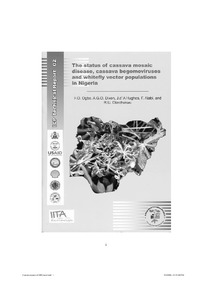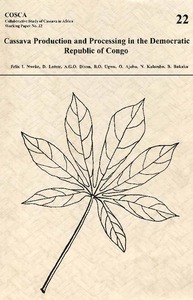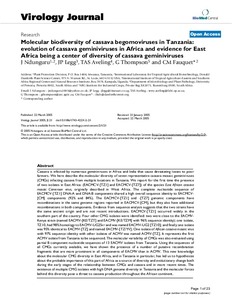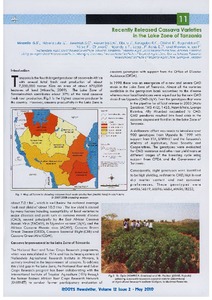| dc.contributor.author | Ogbe, F.O. |
| dc.contributor.author | Hughes, J.A. |
| dc.contributor.author | Alabi, F. |
| dc.contributor.author | Okechukwu, R.U. |
| dc.date.accessioned | 2019-12-04T11:18:21Z |
| dc.date.available | 2019-12-04T11:18:21Z |
| dc.date.issued | 2005 |
| dc.identifier.citation | Ogbe, F.O., Hughes, J.A., Alabi, F. & Okechukwu, R.U. The status of cassava mosaic disease, cassava begomo-viruses and whitefly vector populations in Nigeria (p. 84). Ibadan: IITA. |
| dc.identifier.isbn | 978-131-240-8 |
| dc.identifier.uri | https://hdl.handle.net/20.500.12478/3176 |
| dc.description.abstract | A diagnostic survey was conducted in 2002 and 2003 to determine the status of cassava mosaic disease (CMD) and cassava mosaic begomoviruses in Nigeria and to ascertain if the virulent Ugandan variant of the East African cassava mosaic virus (EACMV-Ug2) is present in the country. The survey was an activity of a CMD project on measures to protect cassava production in Nigeria from potential devastating effects of a severe form of the disease. Routes were selected in states of the six geopolitical zones in Nigeria and 418 farmers’ cassava fields were visited. The CMD status in each field was rated as mild, moderately severe, or severe. Cassava leaf samples were collected from 1397 plants on which CMD severity was also rated on a five-point scale. Leaf samples of some weeds showing characteristic CMD-like mosaic were also collected. Whitefly counts were made in each farm and samples of this insect vector were collected. The leaf and whitefly samples were tested by polymerase chain reaction for African cassava mosaic virus (ACMV), EACMV, the Ugandan variant of EACMV (EACMV-Ug2), Indian cassava mosaic virus (ICMV), and South African cassava mosaic virus(SACMV). Cassava in most farms in the south–south and middle belt geopolitical zones showed mild CMD symptoms. On the contrary, most farms in the southeast and northeast zones showed either moderately severe or severe symptoms. The number of farms with cassava with either moderately severe or severe symptoms was about the same as the number of farms with cassava with mild symptoms in the southwest and northwest zones. Taking the entire country, 48% of the farms had cassava with either moderately severe or severe symptoms, which was about the same as the proportion of farms (52%) with cassava with mild symptoms. The farms appeared to be randomly distributed. Of the 1397 cassava leaf samples, 1106 had symptoms of which 74.1% tested positive for ACMV alone, 0.3% for EACMV alone, 24.4% for mixed infections by the two viruses, and 1.2% did not react with any of the primers used. The two viruses were also detected in 32% of the 291 symptomless plants. ACMV and EACMV were also detected in the whitefly vector samples. EACMV-Ug2, ICMV, and SACMV were not detected in any of the whitefly or leaf samples. Farms in which ACMV occurred in single infection as well as in mixed infections with EACMV predominated. Most doubly infected plants showed severe symptoms. Two biological variants of ACMV based on symptom expression on cassava in the field were identified. A high number of plants expressed symptoms indicative of mixed infections by the two biological variants and in most cases the symptoms were severe. ACMV and EACMV were detected in a leguminous plant Senna occidentalis (L.) Link and a weed Combretum confertum Lams., which are new natural hosts of the viruses. Most farms in southern Nigeria had whitefly populations of between 5 and 500 per plant compared to farms in the north, which had whitefly populations of between 0 and 4 per plant. A lot of the farms in the northeast and northwest had no whiteflies. The virulent Ugandan variant of CMD was not detected. However, the high proportion of mixed infections by ACMV and EACMV, which could result in recombination events such as the one that produced EACMV-Ug2, and the occurrence of variants of ACMV, demand appropriate measures to safeguard cassava production in the country. The CMD project is therefore timely to provide resistant cassava genotypes to Nigerian farmers to forestall any outbreak of severe CMD, either by natural spread from outside Nigeria or by spontaneous recombination between virus strains already present in the country. |
| dc.language.iso | en |
| dc.subject | African Cassava Mosaic Virus |
| dc.subject | Cassava Leaf Samples |
| dc.subject | East African Cassava Mosaic Virus |
| dc.subject | Geopolitical Zones |
| dc.subject | Symptoms |
| dc.subject | Whitefly |
| dc.subject | Biological Variants |
| dc.title | The status of cassava mosaic disease, cassava begomoviruses, and whitefly vector populations in Nigeria |
| dc.type | Book |
| cg.contributor.affiliation | International Institute of Tropical Agriculture |
| cg.contributor.affiliation | National Root Crops Research Institute, Nigeria |
| cg.coverage.region | Africa |
| cg.coverage.region | West Africa |
| cg.coverage.country | Nigeria |
| cg.authorship.types | CGIAR and developing country institute |
| cg.iitasubject | Disease Control |
| cg.iitasubject | Pests Of Plants |
| cg.iitasubject | Cassava |
| cg.iitasubject | Plant Breeding |
| cg.iitasubject | Plant Diseases |
| cg.iitasubject | Plant Health |
| cg.iitasubject | Plant Production |
| cg.iitasubject | Livelihoods |
| cg.iitasubject | Farm Management |
| cg.accessibilitystatus | Open Access |
| local.dspaceid | 94642 |




